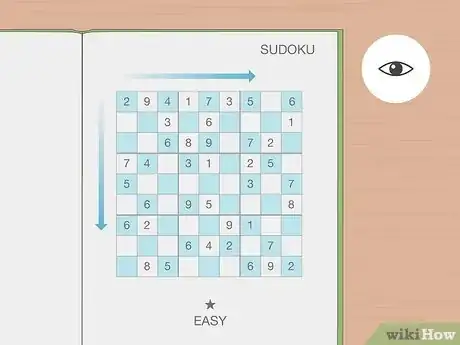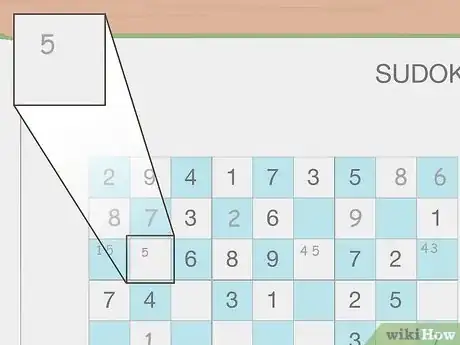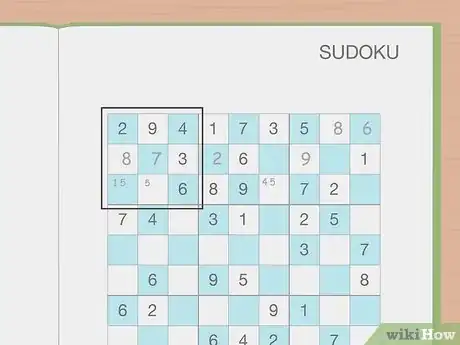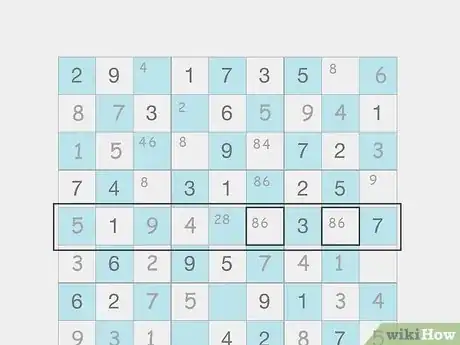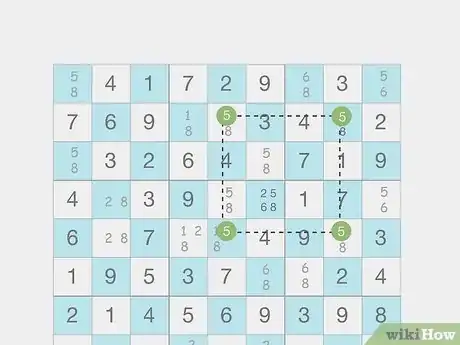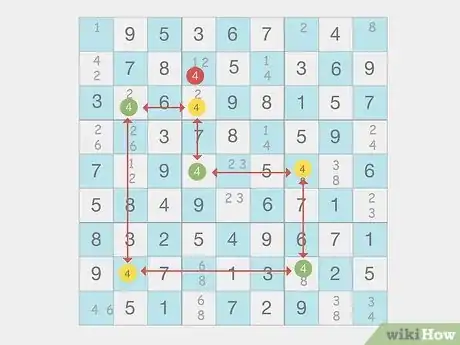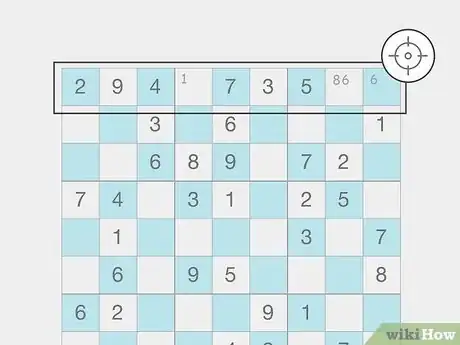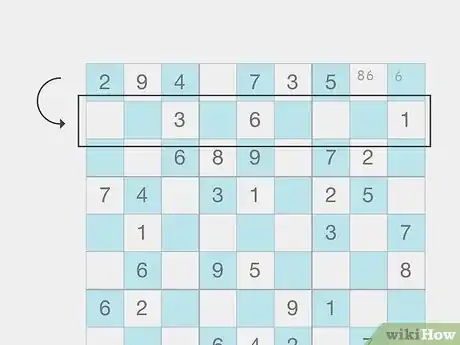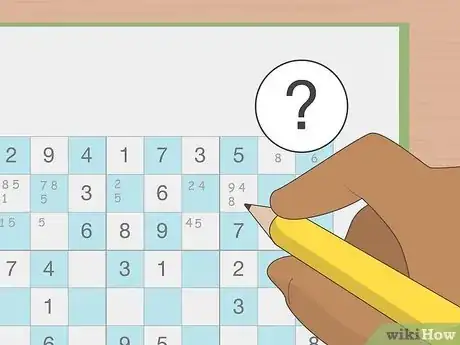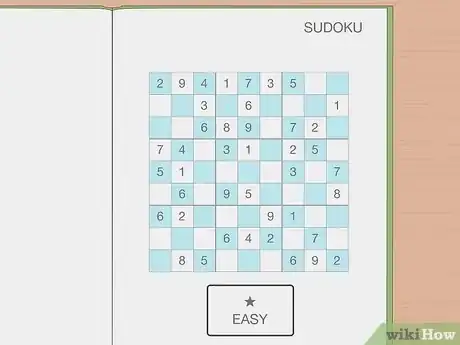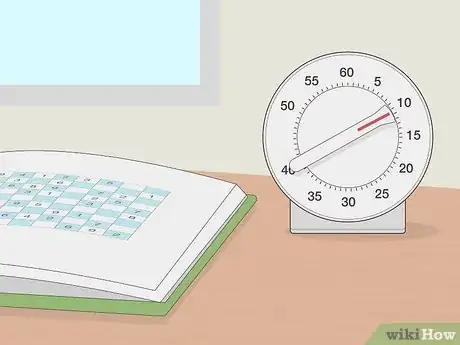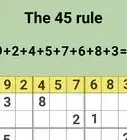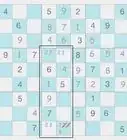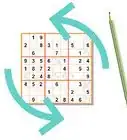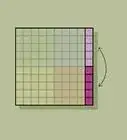This article was co-authored by wikiHow staff writer, Hunter Rising. Hunter Rising is a wikiHow Staff Writer based in Los Angeles. He has more than three years of experience writing for and working with wikiHow. Hunter holds a BFA in Entertainment Design from the University of Wisconsin - Stout and a Minor in English Writing.
There are 10 references cited in this article, which can be found at the bottom of the page.
This article has been viewed 22,031 times.
Learn more...
Have you ever wondered how sudoku masters fly through a puzzle so fast when it feels like it takes you forever? Deducing which numbers fit in the grid can take up a lot of time, but by using a few simple strategies, you can start finishing sudoku puzzles even faster than before. Keep reading for all of the best tips to find the right numbers and shave a few minutes off of your solve time!
Steps
Scan the puzzle for rows, columns, or squares with 1 empty cell.
-
Only one number can go into the cell so you know how to fill it. Start scanning each row from left to right and then check the columns from top to bottom. Check the other numbers in the row, column, or square to see what’s missing so you can fill the cell in.[1] X Research source
- Scanning through the rows and columns also helps familiarize yourself with the entire puzzle right away.
Mark the possible numbers in each square.
-
Filling cells with potential numbers lets you see each possibility for a square. For each empty cell, check which numbers are already present in the same row, square, and column. Since numbers can only appear in a row, column, and 3 x 3 square once, you can deduce that they won’t fit into the empty cell. Use a pencil to lightly write down any leftover numbers into the cell that could still fit. Go through the entire puzzle and fill in each empty cell.[2] X Research source
- If the row contains 2 and 3, the column contains 8, and the square contains 4 and 7, then write 1, 5, 6, and 9 into the cell since they’re the only possible numbers.
Check for new cells that contain one possible number.
-
You may have uncovered cells with one solution after adding pencil marks. After you pencil in all of the potential numbers, scan through the puzzle again for any cells that only have a single number written in them, which are also known as “naked singles.” Since you know nothing else can fit into that cell, you can fill that number in and know that it’s correct.[3] X Research source
- Check the row, column, and square for the cells you just filled in and erase any other times the number you just wrote appears. That may help you find more single cells you can fill in.
- You may also find “hidden singles” in the puzzle. If you notice a number only appears once in the row, column, or square regardless of the other numbers in the cell, then you know that that digit has to go there.
Check for numbers confined to a single column or row in a square.
-
Numbers appearing only in a single row or column in a square must go there. Focus on one 3 x 3 square at a time and scan through all the possible numbers you penciled in. If a number appears in a cell or multiple cells that are in a single row or column, then the number can’t appear in the same section in a different square. You may not know the exact spot for the number yet, but you eliminated options of where it could be somewhere else in the puzzle.[4] X Research source
Search for pairs of cells with the same 2 numbers in a section.
-
The potential numbers have to go into either of the cells in that section. Start by scanning through each row looking for “naked pairs,” or 2 cells that only have the same 2 potential numbers. Since you know that those 2 numbers have to be in those positions, you can erase every other time the numbers appear in the same row. Go through each row before checking for pairs in each column and each 3 x 3 square.[5] X Research source
- If 3 and 9 are the only options for 2 cells in the same column, then erase 3 and 9 pencil marks from the other cells.
- You can also find “hidden pairs” if the pair of numbers are only in 2 cells within the same row, column, or square regardless of other numbers in the square. For example, one cell in a square has 3, 5, 7, and 9 and another cell in the same square has 3, 7, and 8. If 3 and 7 don’t appear anywhere else in the square, then they have to appear in those 2 cells.
Try the X-Wing method to eliminate potential numbers.
-
The X-Wing method reveals 2 spots a number could appear in 2 rows or columns. You can use the X-wing method if 2 cells in the same column have the same possible number, and if the cells line up with empty cells in another column. The empty cells should form a square or rectangle if you connect them with lines. If you draw an X connecting the cells in the corners, then the number can only be in the cells that are connected.[6] X Research source
- For example, if the 4 empty cells could all contain a 5, then the 5 would have to appear in the top corner of one column and the bottom corner of another. You can erase every other 5 in the same rows and columns.
Solve numbers on parallel lines with the Swordfish technique.
-
The Swordfish strategy gives possible placements in 3 rows and columns. To use the Swordfish technique, look for a potential number that’s in 2 cells in the same row. Look for 2 more rows that have 2 empty cells with the same potential number. Draw straight lines between the cells that are in a straight line with each other. If the lines form a closed loop making any shape, then you’ll recognize how you can place the numbers so they don’t intersect.[7] X Research source
- Since the number can never share the same row or column, you limit the possible locations you can place them.
Focus on a section at a time.
-
Sticking with one row, column, or square feels less overwhelming. Rather than trying to work on the entire puzzle at the same time, look at the section of the puzzle that has the fewest empty cells. Try your best to work through and deduce as many of the numbers in that row, column, or square as you can. That way, you’ll have more information to work with when you work on the rest of the puzzle.[8] X Research source
- You can even work on an entire row or column of 3 x 3 squares at a time to help you see which values are missing.
Move to a new section when you get stuck.
-
Working on another part of the puzzle helps you get fresh eyes. If you can’t figure out what the numbers should be in the section you’re working on, don’t be afraid to leave it for now and hop to somewhere else on the sudoku puzzle. You may be able to put in new numbers based on your past deductions, and it could help you figure out the right numbers in the section you were just stuck on.[9] X Research source
Avoid guessing any numbers.
-
You’ll lose a lot of time if you have to go back and correct the puzzle. Sudoku puzzles only have one solution, and you can always deduce a number somewhere on the grid. Rather than making a guess when you don’t know a number, scan through the rows, columns, and squares again and recheck if potential numbers can still fit into the cells. You’re bound to find a cell you can fill or narrow down to certain numbers.[10] X Research source
Start with easier puzzles.
-
Work your way up to difficult puzzles as you learn solving techniques. Easier puzzles tend to have more given numbers and don’t require as many tricks to solve. Look for puzzles that are labeled “easy” or “beginner” if you’re just starting out with sudoku. If you want to test your skills even more, try a “medium” or “challenging” puzzle that takes more advanced solving techniques.[11] X Research source
- “Hard” or “extreme” puzzles are the toughest and give you the least numbers in the grid, so you’ll have to use logic a lot more to fill in the cells.
Set a timer while you solve.
-
You’ll feel more focused when you’re in a time crunch. You can give yourself as much time as you want, but aim for somewhere between 5–15 minutes. After you set your timer, work on your sudoku puzzle without any distractions. If you easily finish within the time frame, then you can try setting even less time for your next puzzle.[12] X Research source
- If the timer goes off before you’re able to finish, try giving yourself a few extra minutes next time.
You Might Also Like
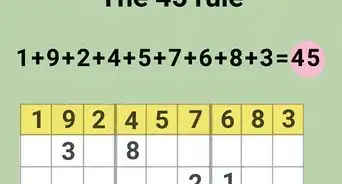


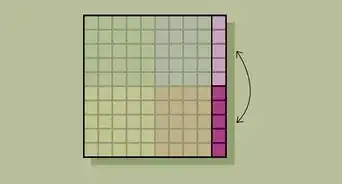 3 Ways to Solve Magic Square Math Puzzles
3 Ways to Solve Magic Square Math Puzzles
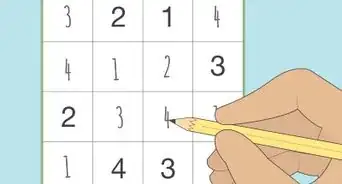
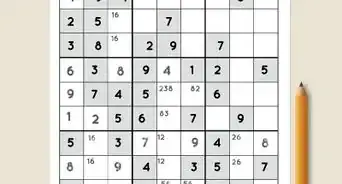 Sudoku Techniques: How to Solve a 3x3 Sudoku Puzzle
Sudoku Techniques: How to Solve a 3x3 Sudoku Puzzle
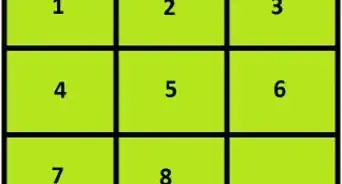

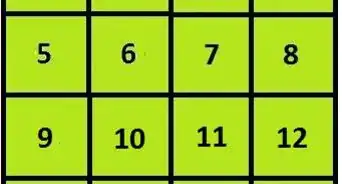
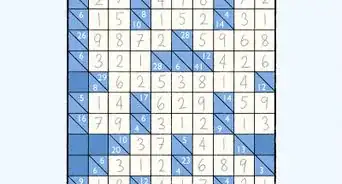
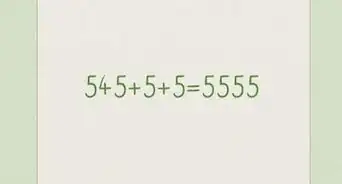 How to Add One Line to Make 100: Answer Revealed
How to Add One Line to Make 100: Answer Revealed
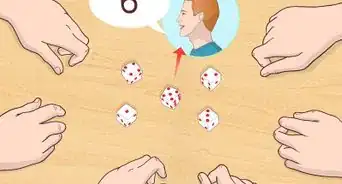
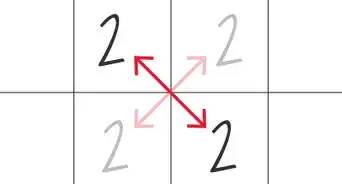
References
- ↑ https://www.stolaf.edu/people/hansonr/sudoku/explain.htm
- ↑ https://www.learn-sudoku.com/pencil-marks.html
- ↑ https://sudokuessentials.com/sudoku_tips/
- ↑ http://hodoku.sourceforge.net/en/tech_intersections.php
- ↑ https://www.sudokuoftheday.com/techniques/naked-pairs-triples
- ↑ https://www.sudokuonline.io/tips/advanced-sudoku-strategies
- ↑ https://www.sudokuonline.io/tips/advanced-sudoku-strategies
- ↑ https://pi.math.cornell.edu/~mec/Summer2009/Mahmood/Solve.html
- ↑ https://masteringsudoku.com/sudoku-tips-tricks/
About This Article

